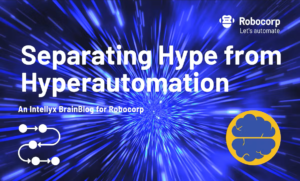BrainBlog for Robocorp by Jason Bloomberg
In the fall of 2019, IT industry analysis firm Gartner announced its top 10 strategic technology trends for 2020. At the top of the list: hyperautomation. Now that it’s almost 2023, has hyperautomation lived up to its hype?
Gartner defines hyperautomation as “an effective combination of complementary sets of tools that can integrate functional and process silos to automate and augment business processes.” Among the tools in this combination: robotic process automation (RPA), process discovery, process mining, intelligent business process management systems (iBPMS), low-code platforms, and business rules engines, among others.
Such a motley list of older and newer product categories generally leaves both enterprise process leaders and software vendors scratching their heads. Is Gartner recommending that companies purchase several process tools to get them to work together? Why is RPA just one item on the list when RPA has taken the enterprise automation market by storm?
Does Gartner consider such a shopping list of tools strategic? The question remains whether hyperautomation is a useful term for describing the next generation of automation technologies – or whether it’s little more than analyst hype.
One question is whether hyperautomation is something qualitatively new or is it simply the natural evolution of automation. If so, do we really need a new term for it?
Hyperautomation Precursors
At the core of hyperautomation, of course, is automation – and automation has been available for centuries. Within the realm of IT, automation dates back at least to the 1960s with applications like enterprise resource planning (ERP), which automated basic accounting processes.
In the 1980s and 1990s, business process management (BPM) software arose, with the goal of providing a platform that enterprises could integrate with various applications, orchestrating interactions with them to support processes that followed flowcharts process analysts laboriously described via complex modeling tools.
While BPM gained some traction, it was only a modest success. The technology’s complexity proved largely unworkable, and in any case, it wasn’t compatible with cloud computing.
Today we have multiple contenders looking to replace the BPM software of old – not coincidentally, the very same technologies that Gartner includes as part of the definition of hyperautomation, as well as digital process automation (DPA) and some others.
Given this historical context, hyperautomation might simply be the next generation of BPM – renamed to give vendors an excuse to sell more gear.
Read the entire BrainBlog here.



